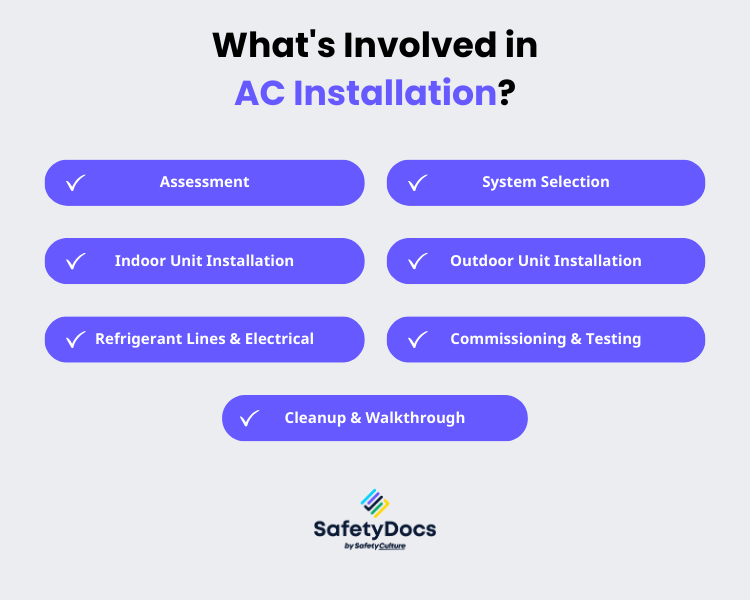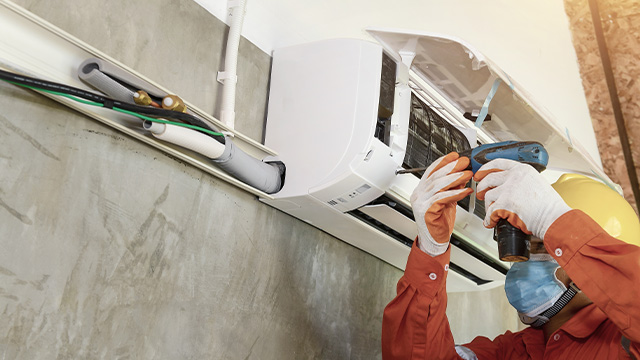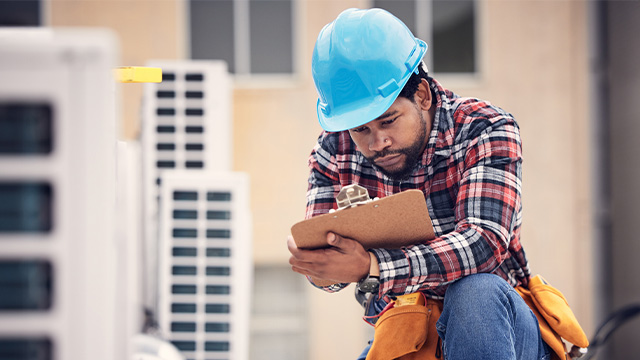Air conditioning installation is complex and demands careful attention to safety. From pressurised components and refrigerants to electrical wiring and ductwork, there's plenty that can go wrong. This guide will help you navigate the installation process safely and effectively.
What's Involved in AC Installation?
Before we dive into the best practices, let's first understand what exactly is involved in air conditioning installation. As mentioned earlier, the process can be complex and involves several components:
- Assessment: A qualified technician assesses your home's cooling needs, considering insulation, orientation, local climate, room sizes, and your preferences. They'll help you choose the right type of AC (split-system, ducted, etc.) and the appropriate size.
- System Selection: Based on the assessment, you'll select an air conditioning system that meets your needs and complies with Australian energy efficiency standards.
- Indoor Unit Installation: The indoor unit (wall-mounted, ceiling cassette, etc.) is installed in the optimal location, ensuring secure mounting and connection to ductwork (if applicable).
- Outdoor Unit Installation: The outdoor unit is placed on a stable base (pad or brackets) in a location with good airflow and minimal noise impact.
- Refrigerant Lines and Electrical: A licensed technician installs refrigerant lines according to Australian standards and connects all electrical components safely, including circuit breakers and disconnects.
- Commissioning and Testing: The system is thoroughly tested and commissioned to ensure optimal performance, refrigerant levels, and airflow. This might involve specific procedures mandated by Australian regulations.
- Cleanup and Walkthrough: The work area is cleaned, old equipment is disposed of responsibly, and the technician provides you with a comprehensive walkthrough of system operation, maintenance, and warranty information.

Hazards in AC Installation
With what's involved in an air conditioning installation, there are several hazards that technicians should be aware of and trained to handle. These include:
Refrigerant Leaks
The refrigerant used in air conditioning units is a chemical that can harm the environment and humans if not handled properly. It can cause frostbite or chemical burns. Technicians must take precautions when working with refrigerants, including wearing protective gear and ensuring proper disposal of leaks or spills.
Electrical hazards
Lock-out/tag-out, arc flash dangers, working with live circuits, and improper grounding are some of the electrical hazards that technicians face when working with air conditioning units. Improperly installed or maintained air conditioning units can pose electrical risks to the technician and the homeowner. High-voltage equipment, such as compressors and motors, must be cautiously handled to prevent electric shock.
Heat Stress
Hot environments can be hazardous to a technician's health. Heat stress, caused by high room temperatures and humidity levels, is a common risk for air conditioning technicians. Technicians must take breaks in cool areas and stay hydrated to avoid heat-related illnesses such as heat stroke or exhaustion.
Fall Hazards
Air conditioning units are often installed on roofs or elevated platforms, which can pose fall hazards for technicians. When working at heights, workers risk falling off the roof or platform. Proper safety precautions must be taken to prevent falls, such as wearing a harness and using scaffolding or ladders with stable footing.
Chemical Exposure
Technicians may encounter various chemicals, such as refrigerants and cleaning agents, while performing air conditioning installation, maintenance, or repair work. If not handled properly, these chemicals can irritate the skin, eyes, and respiratory system.

Safety Measures in Preparing for AC Installation
Before beginning an air conditioning installation, it is essential to follow specific steps to ensure the safety of the technician and anyone in the building. These steps may include:
Assess the Installation Area
Inspect the installation site for any hazards, such as protruding nails, loose wires, or unstable surfaces. Clear the area of obstacles to create a safe working environment.
Prepare Personal Protective Equipment (PPE)
Wear appropriate PPE such as gloves, safety goggles, and non-slip footwear to protect yourself from hazards like sharp edges, electrical shocks, and falling debris.
Safe Work Practices During AC Installation
Follow the manufacturer's instructions
Each AC unit may have specific requirements and guidelines that must be adhered to for optimal performance and safety. Carefully read and follow the manufacturer's instructions.
Require Hazard Identification and Reporting
Your workers must receive training to recognise potential hazards and promptly report them. This can help prevent accidents and ensure the safety of everyone on the installation site. They must identify hazards and report hazards on-site using Hazard Report Forms to implement control measures and reduce the risk of injuries. Reporting is crucial in preventing accidents, as it allows everyone to be aware of potential hazards and take necessary precautions.
Provide adequate training and induction
Employees must receive adequate training, induction, and information about the safe use, installation, and maintenance of air conditioning units to prevent accidents and ensure proper equipment handling. Training must include:
- Basic HVAC/R Skills: Provide training programs that teach essential skills for the HVAC/R industry, emphasising the types of systems most common in Australia (such as split systems and ducted systems). Include air conditioning principles, refrigeration cycles, psychrometrics, system components, and Australian standards for energy efficiency and performance calculations.
- Electrical Skills: AC installers need to have a good understanding of Direct Current (DC) and Alternating Current (AC) electricity, including basic resistance, current, voltage calculations, and the use of test equipment like multimeters and oscilloscopes. Training should explicitly cover relevant Australian electrical codes (e.g., AS/NZS 3000) and safety practices for the specific types of electrical work involved in AC installation.
- Proper handling of refrigerants: Refrigerants are chemical substances in refrigeration and air conditioning systems that facilitate cooling through heat absorption and transfer in a recurring cycle. Employees must be trained on the safe handling and disposal of refrigerants, as they can harm people and the environment.
- Product-Specific Safety: Workers must be trained on the specific hazards associated with different refrigerants. This includes understanding the potential for exposure, skin and eye irritation, and fire hazards.
- Proper Storage: Train on how to store refrigerant cylinders securely to prevent damage, rust, distortion, or corrosion.
- Personal Protective Equipment (PPE): Workers should be trained on adequately using PPE when handling refrigerants, including gloves, goggles, and respirators.
- Automatic Controls: Understanding automatic control components and applications, troubleshooting essential to advanced systems, and ensuring proper functioning of control systems is necessary for AC installers
- Commercial Refrigeration: Training covers commercial refrigeration components, such as evaporators, condensers, compressors, ice machines, and special applications, to equip installers with the necessary knowledge for commercial AC installations
- Air-Conditioning Systems: Knowledge of comfort and psychrometrics, air distribution, energy auditing, installation techniques, and troubleshooting methods for air conditioning systems is crucial for AC installers. Emphasise system selection and sizing appropriate for the Australian climate and in line with Australian energy efficiency standards (such as MEPS).
- All-Weather Systems: Understanding heat gains and losses in structures and knowledge of air sources and domestic appliances prepares installers for various AC system installations.
- Commercial Air-conditioning and Chilled-water Systems: Training covers cooling towers, pumps, chilled-water systems, operation, maintenance, and troubleshooting for commercial AC systems, including packaged rooftop units and variable refrigerant flow systems.
Implement emergency procedures and protocols
An emergency procedure detailing actions to take in emergencies and an emergency contact list should be in place to ensure a swift, efficient and effective response to incidents. The essential components of emergency procedures for AC installation include:
- Emergency Plan: Develop a detailed emergency plan specific to AC installation worksites. Outline responsibilities for each worker, safe zones within the job site, and procedures to ensure everyone's safety during accidents, injuries, equipment malfunctions, or severe weather.
- Electrical Safety: In the event of an electrical hazard, immediately shut off power to the affected area at the main breaker panel if it's safe to do so. Isolate damaged equipment and always call a qualified electrician for repairs.
- Fall Prevention: When working at heights, use appropriate fall protection equipment (harnesses, lifelines) and secure ladders or scaffolding. If a fall occurs, do not move the injured person unless absolutely necessary and call emergency services immediately.
- First Aid: Have a well-stocked first aid kit on-site and ensure at least one team member has basic first aid training. For severe injuries, call emergency services (000 in Australia) without delay.
- HVAC Technician Contact: Have the contact information of a reputable HVAC technician for post-emergency assessment and repairs to the AC system. This can help prevent further damage and ensure proper restoration of the system.
- Communication Plan: Develop a communication plan for emergencies, designating how workers will alert each other, contact supervisors, and reach emergency services. Ensure everyone on the job site is familiar with the plan.
Comply with Australian Standards
Adherence to Australian laws, regulations, and standards for air conditioning installation is essential to ensure safety, reliability, efficiency, and environmental responsibility. These requirements cover equipment selection, installation practices, licensing, refrigerant handling, and more. Here's a breakdown of the key areas:
Licensing Requirements
- Get the Right Licences: All air conditioning and refrigeration work in Australia must be carried out by licensed professionals. Here's what you need:
- Electrical Licence: A Restricted Electrical License or a full Electrician's License (depending on your state/territory) is required for any electrical work involved in AC installation.
- Refrigerant Handling License (ARCtick): Regardless of your primary trade, if you work with refrigerants in AC systems, you need a Refrigerant Handling License from the Australian Refrigeration Council (ARC).
Ozone Protection and Synthetic Greenhouse Gas Management Act 1995
- Responsible Refrigerant Use: This Act aims to protect the environment by minimising harmful refrigerant emissions. Key requirements include:
- Refrigerant Trading Authorisation (ARTA): You need an ARTA from the ARC to legally acquire, store, or dispose of refrigerants.
- Record Keeping: Maintain accurate records of the refrigerants you use and the equipment you service.
- Phase-Out Awareness: Understand the schedules for phasing out older, high-GWP refrigerants in Australia.
Other Important Regulations & Standards
- Building Codes: The National Construction Code (NCC) and state-specific codes set requirements for energy efficiency, ventilation, and other aspects of AC installations.
- Electrical Safety Standards: Safe electrical work is paramount. Always follow AS/NZS 3000 ('Wiring Rules') and any relevant state-specific electrical safety regulations.
- Workplace Health & Safety (WHS): AC installation involves risks beyond just refrigerants and electrical work. Comply with all general WHS regulations for fall protection, safe equipment use, and more.
Remember: Regulations and licensing details can vary slightly between states and territories. Always consult your local authorities for the most up-to-date and specific requirements for your area.
Enhance Job Site Safety with a Comprehensive Safety Pack
Smart air conditioning installers know the value of having a comprehensive Safety Pack readily accessible on-site. A well-prepared pack should include essential documents like Safe Work Method Statements (SWMS), Standard Operating Procedures (SOPs), emergency plans, and more. These documents provide detailed guidance for handling the specific risks of AC installations, like working at heights, rooftop installations, and ductwork.

Your Partner in Safety: SafetyDocs
Safety is a top priority in any industry, especially when handling potentially hazardous materials. As an air conditioning installer, the responsibility for the system's functionality and the safety of yourself and others rests on your shoulders. Partnering with SafetyDocs by SafetyCulture provides you with the tools and support to create a safe and compliant workplace. Readily available safety documentation gives you peace of mind and confidence that you're following the best safety practices.
Let SafetyDocs streamline your safety compliance – we offer pre-made packs with SWMS for AC installations (rooftop work, etc.), SOPs, emergency plans, and even a handy reference guide for relevant codes and legislation. Browse our selection and familiarise yourself with these essential safety resources before your next installation."
- Air Conditioning Safe Work Method Statements Pack
- Air Conditioning OHS-WHS Industry Suite
- Integrated Industry Suite for Air Conditioning
- HVAC-Refrigeration Combo Pack
So, next time you're working on a project, remember to have your safety documentation in check. It's an investment that keeps you safe and gives you peace of mind, knowing that you follow proper safety regulations—ChooseSafetyDocs for all your safety needs.
Our team of experts is dedicated to providing accurate and informative content. Craig Cruickshank, our senior HSEQ advisor at SafetyDocs by SafetyCulture has reviewed this blog post to ensure the highest level of quality.
Learn more about Craig's work on LinkedIn for more industry insights.
Available for instant download and supplied in fully editable MS Word format for use in your business.
Please note that the above information is provided as a comment only and should not be relied on as professional, legal or financial advice.
Share This Article
